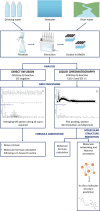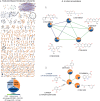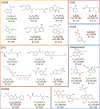Enhancing Molecular Characterization of Dissolved Organic Matter by Integrative Direct Infusion and Liquid Chromatography Nontargeted Workflows
- PMID: 38958378
- PMCID: PMC11256763
- DOI: 10.1021/acs.est.4c00876
Enhancing Molecular Characterization of Dissolved Organic Matter by Integrative Direct Infusion and Liquid Chromatography Nontargeted Workflows
Abstract
Dissolved organic matter (DOM) in aquatic systems is a highly heterogeneous mixture of water-soluble organic compounds, acting as a major carbon reservoir driving biogeochemical cycles. Understanding DOM molecular composition is thus of vital interest for the health assessment of aquatic ecosystems, yet its characterization poses challenges due to its complex and dynamic chemical profile. Here, we performed a comprehensive chemical analysis of DOM from highly urbanized river and seawater sources and compared it to drinking water. Extensive analyses by nontargeted direct infusion (DI) and liquid chromatography (LC) high-resolution mass spectrometry (HRMS) through Orbitrap were integrated with novel computational workflows to allow molecular- and structural-level characterization of DOM. Across all water samples, over 7000 molecular formulas were calculated using both methods (∼4200 in DI and ∼3600 in LC). While the DI approach was limited to molecular formula calculation, the downstream data processing of MS2 spectral information combining library matching and in silico predictions enabled a comprehensive structural-level characterization of 16% of the molecular space detected by LC-HRMS across all water samples. Both analytical methods proved complementary, covering a broad chemical space that includes more highly polar compounds with DI and more less polar ones with LC. The innovative integration of diverse analytical techniques and computational workflow introduces a robust and largely available framework in the field, providing a widely applicable approach that significantly contributes to understanding the complex molecular composition of DOM.
Keywords: LC-orbitrap; dissolved organic matter; environmental water; molecular fingerprinting.
Conflict of interest statement
The authors declare no competing financial interest.
Figures





References
-
- Carlson C. A.; Hansell D. A. DOM Sources, Sinks, Reactivity, and Budgets. Biogeochem. Mar. Dissolved Org. Matter 2015, 65–126. 10.1016/B978-0-12-405940-5.00003-0. - DOI
-
- Hansell D. A.; Carlson C. A.; Repeta D. J.; Schlitzer R. Dissolved Organic Matter in the Ocean a Controversy Stim Ulates New Insights. Oceanography 2009, 22, 202–211. 10.5670/oceanog.2009.109. - DOI
-
- Kumari R. K.; Mohan P. M. Review on Dissolved Organic Carbon and Particulate Organic Carbon in Marine Environment. Ilmu Kelautan 2018, 23 (1), 25–36. 10.14710/ik.ijms.23.1.25-36. - DOI
-
- Dittmar T.; Stubbins A. Dissolved Organic Matter in Aquatic Systems. Treatise Geochem. (2nd Ed.) 2014, 12, 125–156. 10.1016/B978-0-08-095975-7.01010-X. - DOI
MeSH terms
Substances
LinkOut - more resources
Full Text Sources

